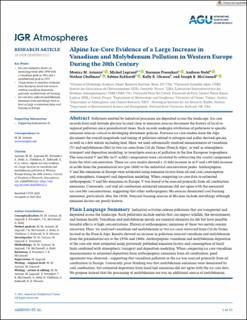| dc.contributor.author | Arienzo, Monica M. | |
| dc.contributor.author | Legrand, Michel | |
| dc.contributor.author | Preunkert, Susanne | |
| dc.contributor.author | Stohl, Andreas | |
| dc.contributor.author | Chellman, Nathan J | |
| dc.contributor.author | Eckhardt, Sabine | |
| dc.contributor.author | Gleason, Kelly E. | |
| dc.contributor.author | McConnell, Joseph R. | |
| dc.date.accessioned | 2021-05-21T11:28:43Z | |
| dc.date.available | 2021-05-21T11:28:43Z | |
| dc.date.created | 2021-04-15T09:09:28Z | |
| dc.date.issued | 2021 | |
| dc.identifier.citation | Journal of Geophysical Research (JGR): Atmospheres. 2021, 126, e2020JD033211. | en_US |
| dc.identifier.issn | 2169-897X | |
| dc.identifier.uri | https://hdl.handle.net/11250/2756038 | |
| dc.description.abstract | Pollutants emitted by industrial processes are deposited across the landscape. Ice core records from mid-latitude glaciers located close to emission sources document the history of local-to-regional pollution since preindustrial times. Such records underpin attribution of pollutants to specific emission sources critical to developing abatement policies. Previous ice core studies from the Alps document the overall magnitude and timing of pollution related to nitrogen and sulfur-derived species, as well as a few metals including lead. Here, we used subannually resolved measurements of vanadium (V) and molybdenum (Mo) in two ice cores from Col du Dome (French Alps), as well as atmospheric transport and deposition modeling, to investigate sources of pollution in the free European troposphere. The noncrustal V and Mo (ncV, ncMo) components were calculated by subtracting the crustal component from the total concentration. These ice core results showed a 32-fold increase in ncV and a 69-fold increase in ncMo from the preindustrial era (pre-1860) to the industrial concentration peaks. Anthropogenic V and Mo emissions in Europe were estimated using emission factors from oil and coal consumption and atmospheric transport and deposition modeling. When comparing ice core data to estimated anthropogenic V and Mo emissions in Europe, V was found to be sourced primarily from oil combustion emissions. Conversely, coal and oil combustion estimated emissions did not agree with the measured ice core Mo concentrations, suggesting that other anthropogenic Mo sources dominated coal-burning emissions, particularly after the 1950s. Noncoal-burning sources of Mo may include metallurgy although emission factors are poorly known. | en_US |
| dc.language.iso | eng | en_US |
| dc.title | Alpine Ice‐Core Evidence of a Large Increase in Vanadium and Molybdenum Pollution in Western Europe During the 20th Century | en_US |
| dc.type | Peer reviewed | en_US |
| dc.type | Journal article | en_US |
| dc.description.version | publishedVersion | en_US |
| dc.rights.holder | © 2021. American Geophysical Union. | en_US |
| dc.source.pagenumber | 15 | en_US |
| dc.source.volume | 126 | en_US |
| dc.source.journal | Journal of Geophysical Research (JGR): Atmospheres | en_US |
| dc.identifier.doi | 10.1029/2020JD033211 | |
| dc.identifier.cristin | 1904205 | |
| cristin.ispublished | true | |
| cristin.fulltext | original | |
| cristin.qualitycode | 2 | |
